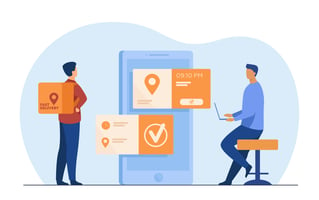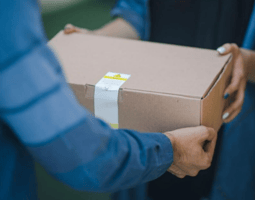According to a recent Statista report, the e-commerce market is expected to reach about 8.1...
Last-mile delivery challenges in 2024
The growth of e-retailing has been instrumental in expanding the scope of last-mile delivery operations.

Amidst the vast opportunities, businesses encounter challenges adapting to the ever-changing and dynamic market expectations. In this write-up, we've compiled the most prevalent last-mile challenges anticipated in 2024 for logistics players to navigate.
What is Last-mile Delivery?
Last-mile delivery marks the final leg of the delivery journey, encompassing the movement of a parcel from the transportation hub to the customer or designated delivery location. This phase accounts for a significant portion of the total shipping cost, ranging from 23% to 53%.
It underscores the essence of this phase in ensuring controlled operational expenses, timely deliveries, and a positive customer experience.
Perfecting last-mile delivery has become a primary concern for logistics businesses. Here are the persistent challenges that delivery businesses commonly face in the last mile.

Challenges of last-mile delivery| 2024
Shrinking Delivery Windows
Compressed delivery windows have emerged as a critical element in the fulfillment cycle due to heightened competition and customer-centric approaches. Businesses in the delivery sector are striving to accommodate narrower delivery windows by expediting and streamlining their delivery processes.
However, the challenge persists as shorter delivery windows and heightened customer expectations significantly challenge last-mile delivery operations.Balancing efficiency with increasingly demanding delivery timelines remains a constant challenge for the logistics players.
Missed deliveries ads low first- attempt delivery rates
There is a subsequent cost associated with every delivery. With the emphasis on swift deliveries, reduced shipping expenses, and heightened efficiency, businesses already operate within tight profit margins.
In this context, failed deliveries or re-attempted deliveries significantly escalate operational costs. Enhancing the First Attempt Delivery Rate (FADR) becomes equally important for sustaining profitability in delivery operations. Given that last-mile delivery represents the final leg of the journey, ensuring successful and timely deliveries has emerged as a pronounced challenge for businesses.
Rising Customer Expectations
Modern customers expect comprehensive information throughout the entire fulfillment cycle, with more focus on delivery in transit status. Beyond staying informed, they also anticipate a branded delivery experience from their service providers.
Any shortcomings in meeting these expectations can be a prime reason businesses lose their loyal customer base. Managing last-mile delivery operations demands constant updates and adjustments to the planned delivery flow, accommodating last-minute changes, additions, or cancellations from customers while ensuring a seamless and satisfactory delivery experience. This adaptability is crucial to meeting evolving customer demands and maintaining loyalty.
Rising Driver Shortages
According to ATA research, there is a projected shortage of 160,000 drivers by 2030. As shipment volumes rise and delivery windows tighten, managing the balance between the available pool of drivers and the increasing daily delivery demands may pose challenges for delivery businesses.
Balancing Act: Profit & costs
Managing profit margins with cost encompasses a delicate equilibrium between incurred costs and revenue generated. Last-mile delivery, which accounts for a significant portion of supply chain costs, presents a challenge for businesses.
The dynamic and rapid evolution of delivery workflows to meet ever-changing customer demands makes it increasingly challenging for delivery businesses to orchestrate supply chain processes while maintaining healthy profit margins. This delicate balance requires constant vigilance and strategic adjustments to ensure efficient operations without compromising profitability.
Parcel Theft
Parcel theft is a persistent problem in deliveries, presenting an ongoing challenge. Issues like parcels delivered to incorrect addresses or getting misplaced are widespread concerns.
This scenario becomes incredibly challenging for businesses, particularly in the last-mile delivery phase, where guaranteeing the precise and secure delivery of parcels becomes a top priority.
Address Inaccuracies
Inaccuracies in shipment addresses pose a series of challenges for delivery businesses. Incomplete addresses, inaccuracies, or incorrect information significantly increase the risk of delays or failures in successful deliveries. These issues complicate the logistics process and often require additional efforts to optimize deliveries.
Secure Communication
Coordinating the fulfillment cycle involves multiple stakeholders at various stages, often necessitating conversations between them. The last mile of delivery faces significant difficulties in securing these communications and preventing the leakage of private information.
Ensuring the confidentiality and integrity of communications among stakeholders remains a critical aspect of maintaining a secure and efficient last-mile delivery operation.
Managing Returns
Managing reverse logistics has emerged as a significant concern for businesses. The escalating volumes of return shipments pose challenges in balancing operational costs while accommodating the expenses associated with managing returns.
Striking a balance between efficient operations and the costs incurred in processing returns remains a critical challenge within the logistics landscape. Finding ways to optimize reverse logistics processes without disproportionately impacting operational expenses is a key focus for many businesses.

How to solve Last-mile Delivery Challenges?
The last-mile segment of the fulfillment cycle has been a crucial part that can support the growth of delivery operations. If handled precisely, last-mile delivery can help businesses overcome operational and on-ground challenges and map the untapped prospects for growth within the delivery landscape.
Here’s how to overcome last-mile delivery challenges.
Integrate Automation to Delivery Cycle
Implementing a dispatch management solution that supports automation is a powerful solution to the challenges of shortened delivery windows. Automating the entire order-to-delivery cycle significantly reduces the time required to plan and execute the fulfillment process. This streamlines operations and elevates efficiency to its optimal level, ensuring smoother and quicker deliveries within tight timeframes.
Advanced Route Planning
Route optimization plays a pivotal role in the efficient management of delivery operations. Intelligently assigning and distributing tasks to the most suitable delivery agents ensures adherence to Service Level Agreements (SLAs) and prevents delivery service area overlaps. Furthermore, it maximizes the number of deliveries completed on a single route, enhancing overall efficiency and productivity.
Embrace Location Intelligence
Location intelligence leverages pre-existing data and geospatial insights to map delivery addresses accurately. This technology significantly enhances location accuracy, boosting the First Attempt Delivery Rate (FADR). Precisely pinpointing delivery locations reduces the likelihood of failed deliveries or missed addresses, ultimately improving overall delivery success rates.
Related: Location Intelligence for e-commerce businesses
Introduce Proof of Delivery
Integrating proof of delivery into the delivery process serves as a vital component. It aids in averting post-delivery conflicts by providing concrete evidence of delivery. Additionally, it ensures that the correct parcel is delivered to the intended address, minimizing errors and enhancing customer satisfaction by offering precise verification of successful deliveries.
Final Thoughts
We've thoroughly explored what last-mile delivery encompasses, delved into its challenges, and shared practical tips to optimize the last-mile delivery process for superior outcomes.
For more details, get in touch with our experts.



